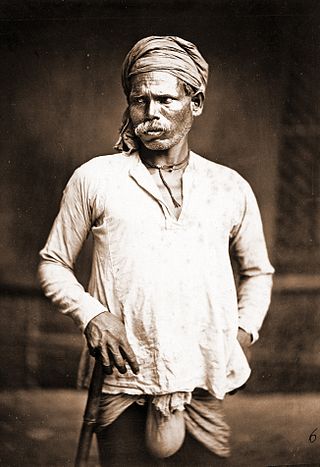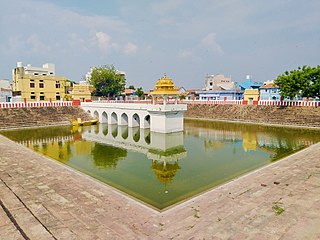Mala is a Telugu caste from the Indian states of Andhra Pradesh and Telangana. They are also present in smaller numbers in the states of Karnataka and Maharashtra. They are considered as Scheduled Caste (SC) or OBC depending on religious status by the Government of India. According to 2001 census data, Malas constituted 41.6 percent of the Scheduled Castes population in the then state of Andhra Pradesh, which also included the present state of Telangana.
The Other Backward Class (OBC) is a collective term used by the Government of India to classify communities that are educationally or socially backward. It is one of several official classifications of the population of India, along with general castes, Scheduled Castes and Scheduled Tribes. The OBCs were found to comprise 52% of the country's population by the Mandal Commission report of 1980 and were determined to be 41% in 2006 when the National Sample Survey Organisation took place. There is substantial debate over the exact number of OBCs in India; it is generally estimated to be sizable, but many believe that it is higher than the figures quoted by either the Mandal Commission or the National Sample Survey.

The Dom, also known as Domra, Domba, Domaka, Dombara and Dombari, are castes, or groups, scattered across India. Dom were a caste of drummer. According to Tantra scriptures, the Dom were engaged in the occupations of singing and playing music. Historically, they were considered an untouchable caste called the Dalits and their traditional occupation was the disposal and cremation of dead bodies. They are in the list of Scheduled caste for Reservation in India in the Indian states of Uttar Pradesh, Bihar, Odisha, Andhra Pradesh, Jharkhand and West Bengal.

Madiga is a Telugu caste from southern India. They mainly live in the states of Andhra Pradesh, Telangana and Karnataka, with a small minority in Tamil Nadu. Madigas are historically associated with the work of tannery, leatherwork and small handicrafts. Today, most are agricultural labourers. They are categorized as a Scheduled Caste by the Government of India. Within the Madiga community, there are various sub-castes include Bindla, Chindu, Dakkali, Mashti, Sangaris and the priestly class is known as Madiga Dasu.

Khammam district is a district in the eastern region of the Indian state of Telangana. The city of Khammam is the district headquarters. The district shares boundaries with Suryapet, Mahabubabad, Bhadradri districts and with Eluru and NTR districts.

Kurnool district is one of the eight districts in the Rayalaseema region of the Indian state of Andhra Pradesh after the districts are reorganised in April 2022. It is located in the north western part of the state and is bounded by Nandyal district in the east, Anantapur district in the south, Raichur district of Karnataka in the northwest, Bellary district of Karnataka in the west, and Jogulamba Gadwal district of Telangana in the north. It has a population of 2,271,686 based on the 2011 census. The city of Kurnool is the headquarters of the district.

Nalgonda district is a district in the Telangana state of India. Nalgonda district has the highest number of mandals in the state with 31 mandals. The district shares boundaries with Suryapet, Rangareddy, Yadadri and Nagarkurnool districts and with the state boundary of Andhra Pradesh. In terms of area, Nalgonda is the largest district with an area of 7222.78 km2 in the state.

Prakasamdistrict is one of the twelve districts in the coastal Andhra region of the Indian state of Andhra Pradesh. It was formed in 1970 and reorganised on 4 April 2022. The headquarters of the district is Ongole. It is located on the western shore of Bay of Bengal and is bounded by Bapatla district and Palnadu districts in the north, Nandyal district in the west, Kadapa and Nellore districts in the south. A part of north west region also borders with Nagarkurnool district of Telangana. It is the largest district in the state with an area of 14,322 km2 (5,530 sq mi) and had a population of 22,88,026 as per 2011 Census of India.
The administrative divisions of India are subnational administrative units of India; they are composed of a nested hierarchy of administrative divisions.

Chamar is a Dalit community classified as a Scheduled Caste under modern India's system of affirmative action. They are found throughout the Indian subcontinent, mainly in the northern states of India and in Pakistan and Nepal.
Arunthathiyar is a scheduled caste community mostly found in the Indian state of Tamil Nadu. The term has two distinct usages: for the purposes of the state government's positive discrimination program, in 2009 it was designated an umbrella term for the Arunthatiyar, Chakkiliyar (Sakkiliyar), Madari, Madiga, Pagadai, Thoti and Adi Andhra communities with a total population of 2,150,285, accounting for 14.89% of the Scheduled Caste population according to the 2011 Census of India. While the Office of the Registrar-General, which administers the census of India, does not recognize all of those communities as one.
Adi-Andhra is a Telugu caste found in the Indian states of Andhra Pradesh and Telangana, primarily in the Coastal Andhra region. They are categorised as a Scheduled Caste by the Government of India.
The Tsundur Massacre refers to the killing of several Dalit people in the village of Tsundur, Guntur district, Andhra Pradesh, India, on 6 August 1991. 8 Dalits were massacred by Reddy men with the alleged help of the police. When a young graduate Dalit youth was beaten because his feet unintentionally touched a Reddy woman near a cinema hall, the Dalits of the village supported him. As a result, Dalits were socially boycotted by the Reddy landowners of the village. Many Dalits have lost their livelihood as they depend on the daily wages by working in the paddy fields of the Reddys. The significance of this atrocity was Dalits collectively fought to gain legal justice by invoking SC/ST Prevention of Atrocities Act 1989.
Relli is a social group of South Indians who reside in the Indian states of Andhra Pradesh, Odisha, West bengal, and Chhattisgarh. They are classified as a Scheduled Caste.
Karamchedu massacre refers to an incident that occurred in Karamchedu, Bapatla district of Andhra Pradesh on 17 July 1985, where brutality by Kamma landlords against Madigas (Dalits) resulted in the killing of six Madigas and grievous injuries to many others. Three Madiga women were raped. Hundreds of Madigas in the village were displaced from their home & killed after their houses were burnt and looted.
Bapatla mandal is one of the 25 mandals in Bapatla district of the state of Andhra Pradesh, India. It is under the administration of Bapatla revenue division and the headquarters are located at Bapatla. The mandal is bounded by Kakumanu, Ponnur, Karlapalem mandals of Guntur district. It also shares borders with Prakasam district and a portion of it lies on the coast of Bay of Bengal.

Nirmal district is a district located in the northern region of the Indian state of Telangana. The district headquarters is located in the town of Nirmal. It borders the Telangana districts of Adilabad, Nizamabad, Mancherial, Asifabad, Jagtial districts as well as Nanded district of the state Maharashtra.

Jagtial district is a district located in the northern region of the Indian state of Telangana. Its administrative headquarters is the city of Jagtial. The district shares boundaries with Nirmal, Mancherial, Karimnagar, Peddapalli, Sircilla and Nizamabad districts.








